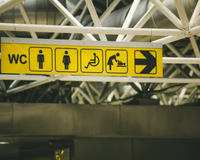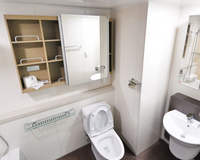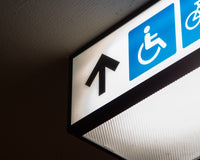According to the National Restaurant Association, there are more than 1,000,000 locations serving food in the U.S.
What do all of the places have in common?
- They all have restrooms
- They all are covered by the Americans with Disabilities Act (ADA)
Restrooms in restaurants are an important part of the customer experience, but they also have to meet certain requirements set forth by the Americans with Disabilities Act (ADA) to ensure accessibility for all individuals.
Different agencies are in charge of enforcement. They can sometimes conflict. Top all of that off with large fines or lawsuits if you get it wrong.
What are you supposed to do? As a veteran-owned business with a focus on making public restrooms available to everyone, Choice Builder Solutions is here to tell you what makes the bathrooms at your establishment ADA compliant. Find out more here.
ADA Is a Federal Law
The Americans with Disabilities Act (ADA) sets forth requirements for accessible restrooms in public accommodations, including restaurants. Here are some of the key requirements:
-
Size: The restroom must be large enough to accommodate a wheelchair user, with a minimum width of 60 inches and a minimum depth of 56 inches.
-
Doorways: The doorway to the restroom must be at least 32 inches wide, and the door must be able to be opened and closed with a force of 5 pounds or less.
-
Toilets: At least one toilet stall in the restroom must be designed for use by individuals with disabilities. The stall must be at least 60 inches wide, and the toilet must be between 17 and 19 inches above the floor. The stall must also have grab bars on both sides of the toilet, with the bars being at least 36 inches long and mounted between 33 and 36 inches above the floor.
-
Sinks: The sink must be accessible to individuals in wheelchairs, with a clearance of at least 29 inches from the floor to the bottom of the sink. The faucet must be operable with one hand, and the sink must be equipped with lever handles or push buttons.
-
Signage: The restroom must be clearly marked with the international symbol of accessibility (ISA), and the sign must be mounted on the door or wall adjacent to the door.
These are just a few of the requirements set forth by the ADA for accessible restrooms in public accommodations. For more information, you can consult the ADA Standards for Accessible Design, which provide detailed guidelines for compliance.
How Many Water Closets?
The number of water closets (toilets) required for a restaurant will depend on the occupancy load of the restaurant as determined by local building codes. Generally, building codes require a certain number of plumbing fixtures based on the occupancy of the building.
For example, the International Plumbing Code (IPC) requires that there be at least one water closet for every 40 people, or fraction thereof, using the restaurant at any given time. If the restaurant has a maximum occupancy load of 80 people, then the IPC would require at least two water closets.
However, it's important to note that local codes may differ and may have their own requirements for restaurants. It's always best to consult with your local building department or code official to determine the exact requirements for your restaurant.
Related: How to Make a Restroom ADA-Compliant
Accessories in Restrooms
Yes, restaurants are required to provide certain accessories in their restrooms to ensure accessibility and convenience for all individuals. The Americans with Disabilities Act (ADA) sets forth requirements for accessible restrooms in public accommodations, including restaurants, and these requirements include specific accessories.
Some of the required accessories for restrooms in restaurants include:
-
Toilet paper dispensers: Toilet paper dispensers must be mounted so that the centerline of the dispenser is between 7 and 9 inches in front of the toilet, and the dispenser must be mounted at a height between 19 and 26 inches above the floor.
-
Soap dispensers: Soap dispensers must be mounted within easy reach of the sink, and the dispenser must be operable with one hand.
-
Hand dryers or paper towel dispensers: Restaurants must provide either hand dryers or paper towel dispensers for drying hands. If a hand dryer is used, it must be mounted so that the outlet is no higher than 48 inches above the floor, and the dryer must be activated by a button, sensor, or other automatic means. If a paper towel dispenser is used, it must be mounted within easy reach of the sink.
-
Waste receptacles: Waste receptacles must be provided in the restroom, and they must be mounted so that the centerline of the receptacle is between 27 and 40 inches above the floor.
These are just a few of the required accessories for restrooms in restaurants. It's important for restaurant owners to consult the ADA Standards for Accessible Design to ensure they are meeting all requirements for restroom accessories in their establishment.
Rules for New vs. Established Restaurants
Restroom rules for new and established restaurants are generally the same, as both are required to meet the same accessibility requirements set forth by the Americans with Disabilities Act (ADA) and local building codes. However, there are some differences in terms of compliance deadlines and the level of flexibility given to established restaurants.
New Restaurants New restaurants are required to comply with all current ADA requirements for accessibility when designing and building their restrooms. The design and construction of restrooms must meet the specific requirements for space, fixtures, and accessories, as well as comply with all local building codes. If a new restaurant fails to meet these requirements, they may face fines, legal action, or be forced to modify the restroom to meet ADA standards.
Established Restaurants Established restaurants, on the other hand, may have more flexibility when it comes to compliance deadlines. While they are still required to comply with ADA requirements, they may have a grace period to make necessary modifications to their restrooms. This grace period varies depending on the state and local regulations, and can range from a few months to several years. During this grace period, the establishment may be allowed to operate their existing restrooms as is, but they must demonstrate a good-faith effort to bring their restrooms up to code by the deadline.
It's important to note that even established restaurants cannot discriminate against individuals with disabilities, and must provide reasonable accommodations to ensure accessibility. This may include providing temporary accommodations or alternate accessible restroom facilities during the transition period.
In conclusion, the restroom rules for new and established restaurants are generally the same, but established restaurants may have a grace period to bring their restrooms up to code. However, regardless of the age of the restaurant, all must comply with ADA requirements and local building codes to ensure accessibility and convenience for all individuals.
State and Local Restroom Requirements for Restaurants

State and local restroom requirements for restaurants may vary, but they all generally follow the guidelines set forth by the Americans with Disabilities Act (ADA) for accessibility and convenience. Here are some examples of state and local requirements for restaurants:
California: In California, restaurants are required to have at least one unisex restroom in addition to any gender-specific restrooms, and all restrooms must be accessible to individuals with disabilities. The restrooms must be clearly marked with signage, and must include features such as grab bars, accessible sinks, and toilet paper dispensers.
New York City: In New York City, all restaurants are required to provide restrooms for their customers, and these restrooms must be accessible to individuals with disabilities. The restrooms must be clearly marked with signage, and must include features such as grab bars, accessible sinks, and toilet paper dispensers. In addition, restaurants with 20 or more seats must have at least one gender-neutral restroom.
Texas: In Texas, restaurants are required to provide restrooms for their customers, and these restrooms must be accessible to individuals with disabilities. The restrooms must be clearly marked with signage, and must include features such as grab bars, accessible sinks, and toilet paper dispensers. In addition, Texas requires restaurants to provide separate facilities for men and women, unless a unisex facility is available.
Florida: In Florida, restaurants are required to provide restrooms for their customers, and these restrooms must be accessible to individuals with disabilities. The restrooms must be clearly marked with signage, and must include features such as grab bars, accessible sinks, and toilet paper dispensers. Florida also requires restaurants to provide separate facilities for men and women, unless a unisex facility is available.
It's important for restaurant owners to consult their local building codes and regulations to ensure they are meeting all requirements for their restrooms. Failure to comply with state and local requirements can result in fines, legal action, or other penalties.
Keeping Track of Local Laws
In addition to ADA enforcement for the local health department, many building and safety codes include basic ADA enforcement. Local laws may be more stringent.
There are several nonprofit organizations that can assist you in determining ADA compliance. In addition, local experts in architecture, contracting and installations may be helpful.
Your local Chamber of Commerce and National Restaurant Association Representative may offer additional insight.
Why Bother With Accessibility?
Restroom accessibility is important for a variety of reasons, and it's essential that all public accommodations, including restaurants, provide accessible restrooms for their customers. Here are some reasons why restroom accessibility is important:
-
It's a legal requirement: Restroom accessibility is mandated by the Americans with Disabilities Act (ADA), which prohibits discrimination on the basis of disability in all areas of public life, including public accommodations such as restaurants. Failure to comply with ADA requirements can result in legal action, fines, and other penalties.
-
It's a matter of inclusivity: Accessible restrooms are essential for individuals with disabilities, allowing them to use the facilities independently and with dignity. This is particularly important for individuals with mobility impairments, who may require features such as grab bars and accessible sinks to use the facilities safely.
-
It's good for business: Providing accessible restrooms can improve customer satisfaction and increase business. Customers with disabilities and their families and friends are more likely to frequent establishments that provide accessible facilities, and word-of-mouth recommendations can also bring in new customers.
-
It's the right thing to do: Ensuring that all individuals have access to essential facilities such as restrooms is a matter of basic human rights and dignity. Providing accessible restrooms is a simple and effective way to ensure that all individuals are treated with respect and equality.
In conclusion, restroom accessibility is important for legal compliance, inclusivity, business success, and basic human rights. Restaurant owners should ensure that their restrooms meet ADA requirements and provide features that make them accessible to all individuals, regardless of their abilities.
Plan for Accessibility From the Beginning
Whether it's a start from scratch or a simple upgrade, restroom requirements for restaurants are complicated. You need professional planning to ensure that you meet all the points of the law. Your architect and contractor can get you started.
The local planning department, building and code enforcement, and health department all have some say in ADA enforcement. You may find conflicting advice. Federal law lays out specific design guidelines but state and local laws may be stricter.
Looking for ADA experts? Contact Choice Builder Solutions today to find out how we can ensure your restaurant's bathrooms are accessible to disabled Americans and veterans, empowering all of your customers with our innovative designs.






7 comments
Patron
We have a small bar restaurant in our small town. The most used restroom in the place has no handicap rail in it. I’ve asked numerous times. Nothing being done. What is the next step?
Anonymous
Yamato Sushi in Copley Boston rest room filthy and combine with employees bathroom too. No toilet paper . No hand paper towel and no electric dryer. Not in regulations. My manager ignored complaints.
Dorothy
How can so many NYC restaurants get away with having multiple stairs to climb in order to reach the bathroom? I was recently told that I could go next door to another building!
Judith Jean-Antoine
We own a small Caribbean take out in DE our restroom is employee only and there’s a sign, nowadays since most people can’t read purposely they’re still asking to use it. What do we do? You don’t want to turn a customer away but also hygiene, contact desease as well we both are nurses so we know the danger of sharing our restroom with customers. It’s confusing…please give me some guidance…thanks
Judith Jean-Antoine
We own a small Caribbean take out in DE our restroom is employee only and there’s a sign, nowadays since most people can’t read purposely they’re still asking to use it. What do we do? You don’t want to turn a customer away but also hygiene, contact desease as well we both are nurses so we know the danger of sharing our restroom with customers. It’s confusing…please give me some guidance…thanks
Vince manglardi
Any codes concerning transgender bathroom.
James Gober
Reason of pandemic local restaurants closed Doors pickup order at the door. We pleased a order to go was refused bathroom use after paying for my order was told go somewhere else bath room out of order.restruntant open went inside to place order used bathroom there before pandemic. No sign out of order or no bathroom posted before purchase. What about ADA customers. Restruntant waiting area seats about 20 customers.
WHAT IS THE LAW STATE OF GA.